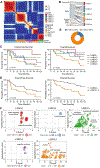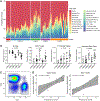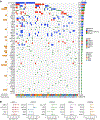Molecular classification and identification of an aggressive signature in low-grade B-cell lymphomas
- PMID: 37254453
- PMCID: PMC10592585
- DOI: 10.1002/hon.3187
Molecular classification and identification of an aggressive signature in low-grade B-cell lymphomas
Abstract
Non-follicular low-grade B-cell lymphomas (LGBCL) are biologically diverse entities that share clinical and histologic features that make definitive pathologic categorization challenging. While most patients with LGBCL have an indolent course, some experience aggressive disease, highlighting additional heterogeneity across these subtypes. To investigate the potential for shared biology across subtypes, we performed RNA sequencing and applied machine learning approaches that identified five clusters of patients that grouped independently of subtype. One cluster was characterized by inferior outcome, upregulation of cell cycle genes, and increased tumor immune cell content. Integration of whole exome sequencing identified novel LGBCL mutations and enrichment of TNFAIP3 and BCL2 alterations in the poor survival cluster. Building on this, we further refined a transcriptomic signature associated with early clinical failure in two independent cohorts. Taken together, this study identifies unique clusters of LGBCL defined by novel gene expression signatures and immune profiles associated with outcome across diagnostic subtypes.
Keywords: genetics; immune; lymphoma; signatures; transcriptomics.
© 2023 The Authors. Hematological Oncology published by John Wiley & Sons Ltd.
Conflict of interest statement
Conflict-of-Interest Disclosures: A.J.N., Research Funding, Celgene Bristol Myers Squibb. M.A.H., K.W., K.T.H., J.E.K., A.R.D., J.P.N., M.K.M., M.R.S., V.S., M.C.L., Z.Y., M.J.M., J.P., E.D.M., T.M.H., B.K.L., L.M.R., S.M.A., J.R.C., and D.J. declare no competing financial interests.
Figures




References
MeSH terms
Grants and funding
- T32 AI170478/AI/NIAID NIH HHS/United States
- U01 CA195568/CA/NCI NIH HHS/United States
- T32AI007425/CA/NCI NIH HHS/United States
- T32AI170478/CA/NCI NIH HHS/United States
- R01 CA212162-01A1/CA/NCI NIH HHS/United States
- R01 CA212162/CA/NCI NIH HHS/United States
- P50 CA097274/CA/NCI NIH HHS/United States
- SPORE-P50 CA97274/CA/NCI NIH HHS/United States
- T32 AI007425/AI/NIAID NIH HHS/United States
- R01 CA212162-01A1/CA/NCI NIH HHS/United States
- SPORE-P50 CA97274/CA/NCI NIH HHS/United States
- U01 CA195568/CA/NCI NIH HHS/United States
- T32AI007425/CA/NCI NIH HHS/United States
- T32AI170478/CA/NCI NIH HHS/United States
LinkOut - more resources
Full Text Sources
Molecular Biology Databases

